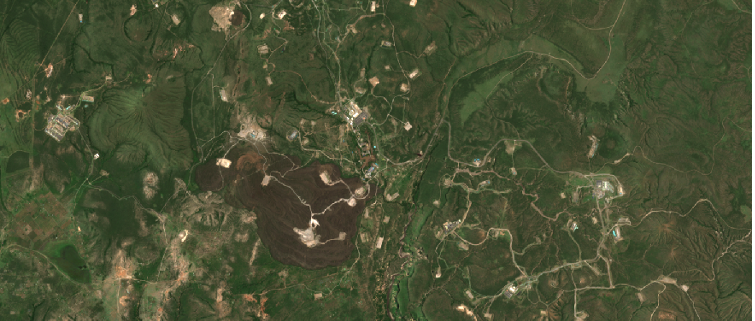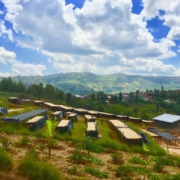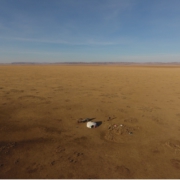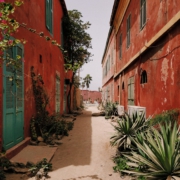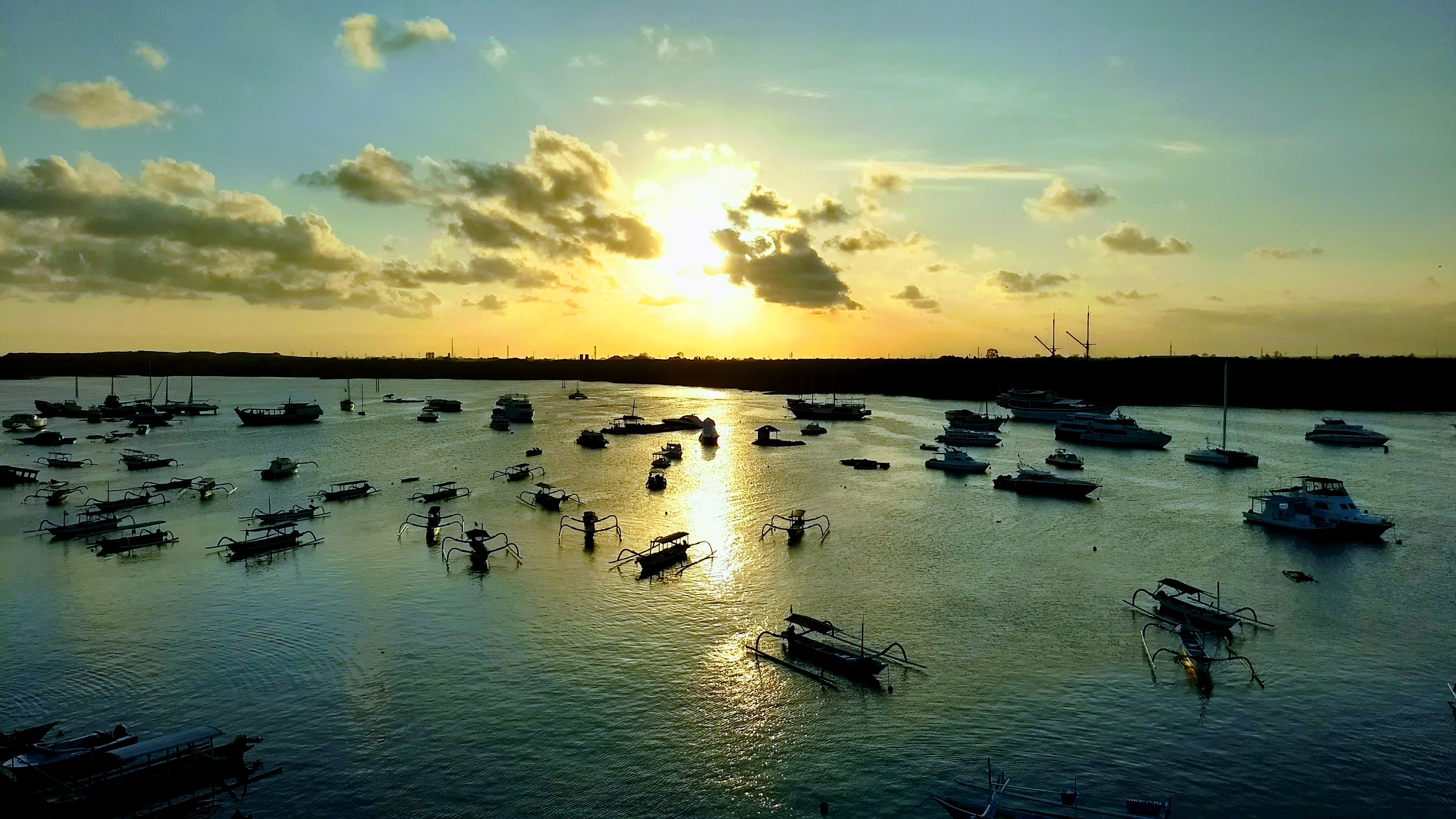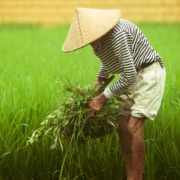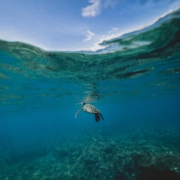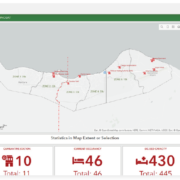gEOthermalKenya: Space for Communities (IPP Project Blog)
The gEOthermalKenya team has been working with Kenyan government partners to enhance the uptake of satellite EO data for the Environmental and Social Impact Assessment (ESIA) process associated with the country’s expanding geothermal energy sector. The project has been funded through UKSA’s International Partnership Programme, part of the Global Challenges Research Fund (GCRF).
Kenya has ambitious development goals over the coming decade, with energy forming an integral part of them. In 2018, the government developed a roadmap to providing universal electricity access to their 55 million citizens by 2022. This target also forms a central target within the country’s Vision 2030 plan of becoming an industrialised middle-income country. To reach these targets by 2030, the country’s electricity capacity is required to increase by more than three times from 2017 values[1].
In addition to these energy targets, the country has also signed up to the Paris Climate Agreement. This requires their greenhouse gas emissions to be reduced by 30% relative to a “business as usual” scenario by 2030. This means that any increase in electricity production as part of Vision 2030 must be achieved without increases to harmful emissions typically associated with fossil fuel sources. Green energy sources (e.g. solar, wind, hydro) are therefore integral to the countries energy and climate aspirations.
Figure: Satellite image of Olkaria volcano and geothermal area. Visible are the borehole sites where steam is extracted from the subsurface (rectangular cleared areas in the center of the image) with access roads running between them. Greenhouses that utilise the excess steam can be seen to the north along with other agricultural land use. (Credit: Google Earth Engine).

Another energy source that is central to Kenya’s energy plan is geothermal, which uses heat from volcanic sources deep within the Earth to produce steam. Due to its geographic location along the East African Rift Valley, the area is abundant in active volcanoes which has led to it already becoming the largest producer of geothermal energy in Africa and eighth in the world[2].
The other key element here is that almost all geothermal ventures within Kenya are backed by funding from International Financing Institutes (IFIs), such as the European Investment Bank and the World Bank Group). IFIs have repeatedly expressed commitment to develop objective metrics to monitor progress and flag problems at an early stage.
The Olkaria region, located around 80km NW of the capital Nairobi, is the jewel in the crown of Kenya’s geothermal infrastructure. Beginning in the early 1980s, the site has grown significantly into the largest geothermal facility in the country with 5 power stations and hundreds of steam extraction and reinjection wells, with plans for a further 2 stations in the surrounding area. The currently installed capacity at the site is 877MW[3], just over a third Kenya’s overall capacity[4].
Despite this, there have been a number of issues associated with expansion of the development. For instance, much of the geothermal infrastructure is situated within a designated national park, Hell’s Gate. This has led to concerns regarding the natural beauty of the region being compromised due to the extensive borehole and pipe network for steam transport and access roads for site vehicles[5]. In addition, there are reports of endangered species of bird no longer breeding in the area, access routes for native animal species being cut off, polluted water sources and removal of vegetated areas[6].
Several local villages, mostly indigenous communities, have been relocated to accommodate the expanding geothermal infrastructure. While many of these relocations were negotiated and agreed to, reports by media and NGOs suggest that language barriers meant that many of the relocated people did not fully understand what was entailed. This has led to complaints regarding a reduction in available land, unsuitable housing, poor quality soil, access issues due to landslides and the remote location of the resettlement site. There have also been recent instances of forced relocation without compensation; negative press and lobbying around those rights violations led to the withdrawal of a $192m European Investment Bank loan for the Akiira I site[7].
This is the backdrop to the discussions that eventually became the gEOthermalKenya project. Important, timely investment in renewables risks being compromised by a lack of due diligence when it comes to environmental and social standards. As well as harming local communities and the natural environment, this is costing governments and companies significant amounts of money. EO data obtained based on agreed research parameters responds to this need, supporting corrective action within the project lifecycle and avoiding late-stage funding withdrawal, or indeed expensive litigation.
Several of the key issues raised in Olkaria, for instance, can be investigated and monitored using satellite EO data, leading to the formulation of the gEOthermalKenya project. The overarching goal of the project is to facilitate the environmentally, socially and financially sustainable growth of the Kenyan geothermal sector. The project aims to facilitate this through the increased incorporation of state-of-the-art EO approaches into the existing ESIA approach.
The project was devised prior to the emergence of the COVID-19 pandemic, leading to several unforeseen limitations. The biggest issue was the ban on international travel, which meant that no face-to-face meetings could take place to build relationships with in-country stakeholders, and the project team had no opportunity to visit the geothermal sites to acquire ground information to aid the interpretation of the remotely processed satellite data. This meant that extensive video conference calls were required and a huge reliance on mutual contacts to grow our in-country network. The UK High Commission in Nairobi played a crucial role in this regard.
Critical to delivering a meaningful solution to the problem we had identified was engagement with the NEMA, which oversees the ESIA process. We needed to understand their various roles within the geothermal sector, their current EO capacity and their requirements to enhance their current processes. Further interaction with the Kenyan Space Agency was invaluable to understanding where our UK-based partnership could help improve current practices around the use of EO data to inform policy-making.
One of the most important connections made during the project is with the British Institute in East Africa (BIEA) and their Prosperity Colab (PROCOL) Kenya initiative[8]. PROCOL conducts collaborative research into how communities in Kenya can become sustainable, autonomous and resilient. Through this connection, Omanos was able to commission a number of invaluable ground data collection exercises that would not have been possible otherwise. This included gathering current land use information in the vicinity of the geothermal sites, using a combination of mapping and interviews with village elders, farmers, and others affected by the geothermal developments.
This data was used to train the satellite data processing approaches used by GSI. It was also possible to perform interviews with local communities affected by the geothermal sites to provide insights into their experiences. This allowed the identification of several recurring negative impacts, including air quality, water quality, noise and employment opportunities. This also led to a second field exercise, where water, soil and noise samples were taken to verify the reports from the community interviews. Samples were tested at a local lab in Kenya.
The importance of the community engagement process is multifaceted – and central to the success of this Discovery Phase project. Firstly, it provided invaluable data that was subsequently used in the training of machine learning algorithms designed to characterize land-use around geothermal sites and guided insights into the potential community and environmental impacts of future geothermal developments. Secondly, it allowed the development of a start-to-finish processing flow for ground data collection that can be implemented for planned future work associated with the project. Finally, it also provided employment to rural communities that have been badly affected by the COVID-19 pandemic. This highlights the extremely diverse and broad-reaching benefits provided by overseas development funding.
The project as a whole has highlighted the potential for innovative space data solutions to benefit local communities faced with potentially huge changes due to large-scale development. In addition, in regions such as Kenya where there are a number of indigenous communities – each with a deep connection to the land around them – it is imperative that engagement is performed in an ethical, inclusive and participatory manner to ensure meaningful involvement. The gEOthermalKenya project has demonstrated the value of fusing these approaches to ensure that future geothermal projects within Kenya and across the globe are as sustainable as possible, in an attempt to drive the continued production of low-carbon energy in a changing world.
In Kenya, we were exceptionally lucky to be engaging with a government that sees the value of integrating satellite data as an additional layer of evidence in planning and development. Just as there is so much potential to scale this solution, there is a strong foundation for Kenya to emerge as a regional leader in the use of EO data in effective, ethical resource management.
*
For more information about either this particular project or the ongoing development of the EO-enabled ESIA approach, feel free to get in touch!
Figure: Image of the Kenyan field team collecting water samples from the Olkaria geothermal site. One of five currently operating geothermal power plants can be seen in the background. (Credit: Solomon Ntaiyia, PROCOL Kenya).

[1] http://gak.co.ke/wp-content/uploads/2019/02/Updated-Least-Cost-Power-Development-Plan-2017-2022-min.pdf
[2]https://www.thinkgeoenergy.com/thinkgeoenergys-top-10-geothermal-countries-2020-installed-power-generation-capacity-mwe/
[3] https://www.irena.org/publications/2020/Nov/Geothermal-development-in-Eastern-Africa
[4] https://www.bbc.com/future/article/20210303-geothermal-the-immense-volcanic-power-beneath-our-feet
[5]https://www.theelephant.info/features/2020/12/04/geothermal-development-in-kenya-the-good-the-bad-and-the-ugly/
[6] https://www.nationalgeographic.com/environment/2018/10/geothermal-energy-kenya-photography/
[7]https://bankwatch.org/blog/kenyan-village-burned-down-weeks-after-eib-withdraws-from-energy-project-planned-at-the-same-place
[8] https://www.procolkenya.com/

